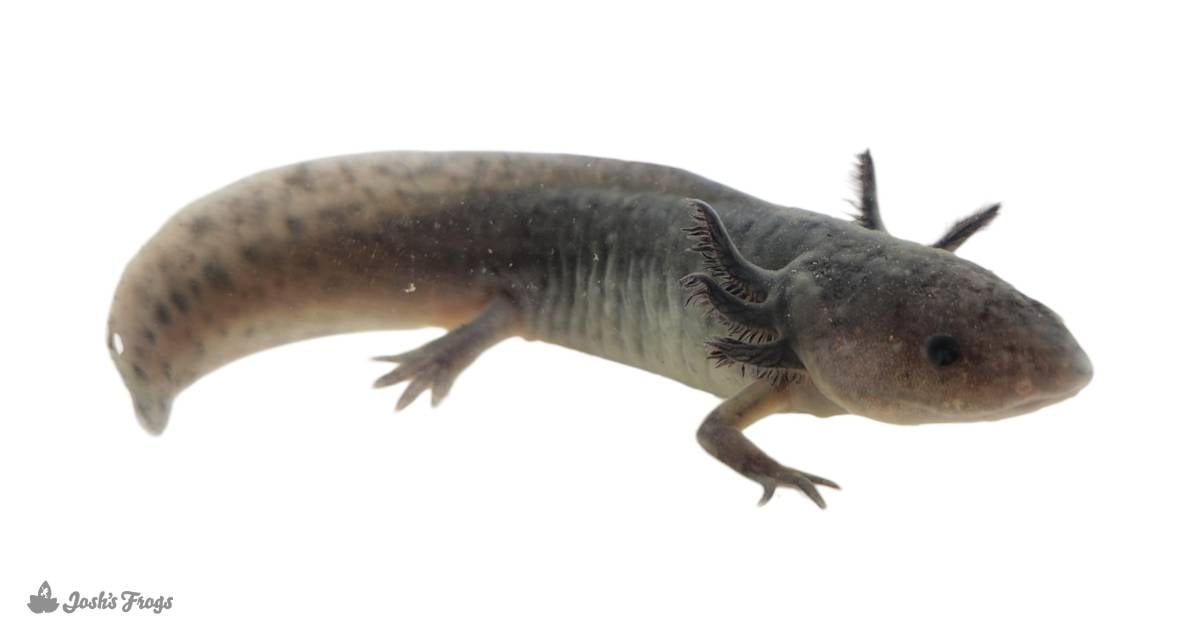Josh's Frogs
A Little About Axolotls
You've probably heard of these salamanders before, maybe under names such as the Water Dragon or Mexican Walking Fish. Axolotl literally translates to water dog—a fitting name given their seemingly innocent, permanently present puppy dog smile.
These neotenic (meaning the adults retain juvenile characteristics) amphibians live in water their entire lives, taking advantage of external gills to breathe underwater. These salamanders are fascinating and, fortunately for us, make great pets if a few simple guidelines are followed.

Housing
When planning how to house your axolotls, figure about 10 gallons of water volume per salamander. Many keepers keep their axies in a bare-bottom setup for easy maintenance, but fine sand or gravel works well, too. Whichever you use, make sure it's fine enough not to be mistaken for food.
Adult axolotls can be housed in groups, assuming all individuals are well-fed and about the same size. Young axolotls will attempt to eat each other, sometimes successfully. Because of this, we house young axolotls individually at Josh's Frogs. When we attempted communal housing, some animals consumed other's limbs. Fortunately for us (and them!), axolotls can quickly regenerate any limbs that are lost.
Environment
Providing a substrate definitely makes the habitat appear more natural, but does make it a bit more difficult to clean. Wood and rocks are acceptable naturalistic décor for the aquarist replicating a natural habitat, while aquarium ornaments or PVC pipe make great basic hides for a more spartan environment—just make sure there are no sharp edges! Your axolotl will feel most comfortable if provided with caves and hides it can disappear into.
Filtration is not absolutely necessary but will help keep your axolotl's aquarium cleaner and reduce the frequency of water changes. Sponge filters work, as well as internal power filters or filters that hang on the back of the tank. Hang on the back filters (often truncated to HOB filters) are probably the easiest to maintain and most effective. These filters will also help increase the oxygen levels in the water, which your axolotl will enjoy.
No need for an aquarium heater to keep your axolotl happy. In fact, you may find you need to invest in an aquarium chiller! Axolotls prefer cooler water, 55°F to 65°F being ideal. You want to try and keep water temperatures below 70°—higher temps can become lethal. A basement is a great place for an axolotl as these areas of the house are naturally cooler.
Appearance and Lifespan
At the time of sale, captive bred red axolotls from Josh’s Frogs will measure about 3-4.5 inches long and be about 4 months old. They can be fairly quick growers, with adults reaching up to about 14 inches in a couple years. The cooler they are kept, the slower axolotls will grow.
These aquatic salamanders can vary pretty wildly in color and pattern:
- Wild type animals (those that appear as they would in the wild) are a mottled dark green or brown in color—perfect for blending in with aquatic vegetation in murky water.
- Albino axolotls appear pink in color, with red eyes and bright red gills. Occasionally, animals are more whitish in color.
- Leucistic animals tend to be white with back eyes.
There are also various other color forms, which can allow the animal to take on a yellowish appearance. Some have even had jellyfish DNA incorporated into their genome, allowing them to glow green under a black light!
They have an average captive lifespan of about 10-15 years with proper care.
Food
Captive bred axolotls will devour thawed bloodworms, 1/4 inch to 1/2 inch cut pieces of nightcrawler, and small axolotl pellets. As they age, axolotls can handle larger and larger food items, including full-size nightcrawlers, large axolotl pellets, and even the occasional feeder insect.
Sexing
Axolotls are easy to sex when mature. Males have a more streamlined, slender body, while females tend to be larger and more round. A male's cloacal region will appear very swollen.Most axolotls can be reliably sexed when they are about 8 inches long, which typically takes 8-10 months.
Natural Range
In the wild, axolotls are critically endangered in their native range in Mexico. This is largely due to invasive species and pollution.
Axolotls are readily available in the hobby, as they have been popular laboratory animals. As startling as this sounds, axolotls can regenerate limbs very quickly, making them a fascinating subject for study. Because of this, a wide range of morphs or color forms are known and readily available.
Think axolotls are the right pet for you?
Do some more research, then get a tank set up and running before you bring your pet gummy lizard home. Axolotls are awesome captives, but please make sure you can meet their needs before you make the plunge.

